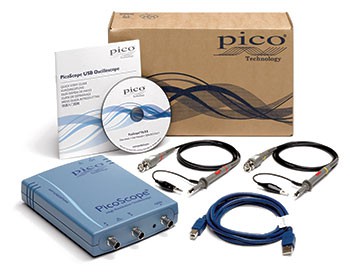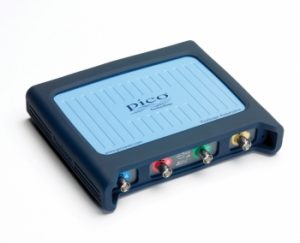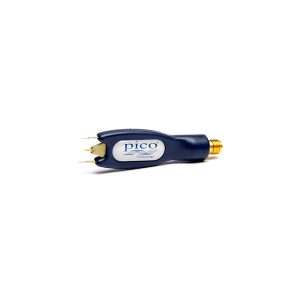Leírás
-
Oscilloscope — vertical Input channels 2 Bandwidth
±20 mV range
±10 mV range5 MHz
4 MHz
3 MHzHardware bandwidth limiter 200 kHz, switchable Rise time (calculated)
±20 mV range
±10 mV range70 ns
88 ns
117 nsInput type Single-ended, BNC connector Vertical resolution 16 bits Enhanced vertical resolution 20 bits Input sensitivity 2 mV/div to 4 V/div (10 vertical divisions) Input ranges (full scale) ±10 mV to ±20 V in 11 ranges Input coupling Software-selectable AC/DC Input characteristics 1 MΩ ±2% || 15 pF ±2 pF DC accuracy (% of full scale)
±50 mV range
±20 mV range
±10 mV range±0.25%
±0.5%
±1%
±2%Overvoltage protection ±50 V (DC + AC peak) Oscilloscope — horizontal Maximum sampling rate (real-time) 10 MS/s Maximum sampling rate
(continuous streaming mode)
Using PicoScope
Using the SDK10 MS/s
10 MS/s one channel (PC-dependent)
6.7 MS/s two channels (PC-dependent)Timebase ranges 1 µs/div to 5000 s/div Buffer memory 16 MS shared between active channels Streaming buffer memory (PicoScope) 100 MS (shared) Streaming buffer memory (SDK) Up to available PC memory Maximum buffer segments (PicoScope) 10,000 Maximum buffer segments (SDK) 32,768 Maximum waveforms per second 9,100 (typical) Timebase accuracy ±50 ppm Sample jitter < 10 ps RMS Dynamic performance (typical) Crosstalk > 50,000:1 Harmonic distortion –95 dB typical @ 10 kHz, –1 dBfs input SFDR 96 dB typical @ 10 kHz, –1 dBfs input Noise 8.5 µV RMS (on most sensitive range) Bandwidth flatness [+0.25 dB, –3 dB] from DC to full bandwidth Pulse response < 1% overshoot on all ranges Triggering (general) Trigger modes Free run, auto, repeat, single, rapid (segmented memory) Maximum pre–trigger capture Up to 100% of capture size Maximum post–trigger delay Up to 4 billion samples Trigger rearm time < 10 µs on fastest timebase Triggering (main inputs) Source Ch A, Ch B Trigger types Rising, falling, adjustable hysteresis, window, pulse width, window pulse width, dropout, window dropout, interval, logic, runt pulse Trigger level Adjustable over whole of selected voltage range Trigger sensitivity Digital triggering provides 1 LSB accuracy up to full bandwidth of scope Maximum pre–trigger capture Up to 100% of capture size Maximum post–trigger delay Up to 4 billion samples Trigger rearm time < 10 µs on fastest timebase External trigger input Trigger types Edge, pulse width, dropout, interval, logic, delayed Input characteristics 1 MΩ ±2% || 15 pF ±2 pF Input type Rear-panel BNC connector Threshold range ±5 V and ±500 mV, DC coupled Sensitivity 25 mV p-p at 1 MHz, typical DC accuracy ±1% of full scale Bandwidth 5 MHz Overvoltage protection ±50 V Signal generator Standard output signals Sine, square, triangle, DC voltage, ramp, sinc, Gaussian, half–sine, white noise, PRBS Standard signal frequency DC to 20 kHz Sweep modes Up, down, dual Frequency accuracy ±50 ppm Frequency resolution < 0.01 Hz Voltage range ±1 V (no load) Amplitude and offset adjustment 100 µV steps (within overall ±1 V range) Amplitude flatness < 0.1 dB to 20 kHz, typical DC accuracy ±0.5% of full scale SFDR 102 dB typical @ 10 kHz, -1 dBfs input Connector type Front-panel BNC Output characteristics 600 Ω Overvoltage protection ±10 V Arbitrary Waveform Generator Update rate 192 kS/s Buffer size 4 096 samples Resolution 16 bits Bandwidth 20 kHz Rise time (10% to 90%) 11 µs, typical Spectrum analyzer Frequency range DC to 5 MHz Display modes Magnitude, peak hold, average Windowing functions Rectangular, Gaussian, triangular, Blackman, Blackman–Harris, Hamming, Hann, flat–top Number of FFT points Selectable from 128 to 1 million in powers of 2 Scale / units X axis : linear or log 10
Y axis : logarithmic (dbV, dBu, dBm, arbitrary) or linear (volts)Math channels Functions −x, x+y, x−y, x*y, x/y, x^y, sqrt, exp, ln, log, abs, norm, sign, sin, cos, tan, arcsin, arccos, arctan, sinh, cosh, tanh, freq, derivative, integral, min, max, average, peak, delay Operands A, B (input channels), T (time), reference waveforms, constants, Pi Automatic measurements Oscilloscope mode AC RMS, true RMS, cycle time, DC average, duty cycle, falling rate, fall time, frequency, high pulse width, low pulse width, maximum, minimum, peak to peak, rise time, rising rate. Spectrum mode Frequency at peak, amplitude at peak, average amplitude at peak,
total power, THD %, THD dB, THD plus noise, SFDR, SINAD, SNR, IMDStatistics Minimum, maximum, average and standard deviation Serial decoding Protocols 1-Wire, ARINC 429, CAN, DCC, DMX512, FlexRay, I²C, LIN, PS/2, SENT, SPI, UART/RS-232, USB 1.0 Inputs All input channels with any mixture of protocols Mask limit testing Mask generation Auto generate from captured waveform, manual drawing, manual coordinate entry Actions Highlight on screen, select in buffer overview, activate alarm Statistics Pass/fail, failure count, total count Alarms Initiating events Capture, buffer full, mask fail Alarm actions Beep, play sound, stop/restart capture, run executable, save current buffer/all buffers, trigger signal generator Display Interpolation Linear or sin(x)/x Persistence modes Digital color, analog intensity, fast, custom Data export Output file formats BMP, CSV, GIF, JPG, MATLAB 4, PDF, PNG, PicoScope data, PicoScope settings, TXT Output functions Copy to clipboard, print Environmental Temperature range (operating) 0 °C to 45 °C Temperature range (stated accuracy) 20 °C to 30 °C Temperature range (storage) –20 °C to +60 °C Humidity range (operating) 5% to 80% RH non-condensing Humidity range (storage) 5% to 95% RH non-condensing Physical properties Dimensions (including connectors) 210 x 135 x 40 mm (approx 8.2 x 5.3 x 1.5 in) Weight < 500 g (approx 1.1 lb) Software Windows software PicoScope for Windows
Software development kit (SDK)
Windows 7, 8 or 10 recommended (read more)macOS software PicoScope for macOS (beta: feature list)
Software development kit (SDK)
OS versions: see release notesLinux software PicoScope for Linux (beta: feature list)
Software development kit (SDK)
See Linux Software & Drivers for details of supported distributionsLanguages Chinese (simplified), Chinese (traditional), Czech, Danish, Dutch, English, Finnish, French, German, Greek, Hungarian, Italian, Japanese, Korean, Norwegian, Polish, Portuguese, Romanian, Russian, Spanish, Swedish, Turkish General Additional hardware (supplied) 2 x TA375 probes, USB 2.0 cable, user manuals PC connectivity USB 2.0 (compatible with USB 1.1 and USB 3.0; USB 1.1 not recommended) Power requirements Powered from USB port Safety approvals European LVD standard EMC approvals European EMC standard Environmental approvals RoHS compliant Total satisfaction guarantee In the event that this product does not fully meet your requirements you can return it for an exchange or refund. To claim, the product must be returned in good condition within 14 days. Warranty 5 years








